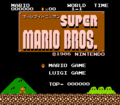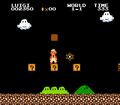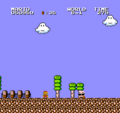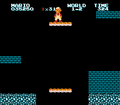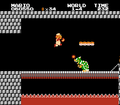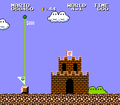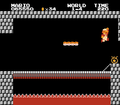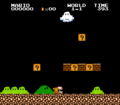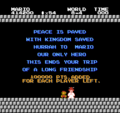All Night Nippon: Super Mario Bros.: Difference between revisions
mNo edit summary |
Mariofan5000 (talk | contribs) (→Differences: Changed the verb tense.) |
||
| Line 17: | Line 17: | ||
==Differences== | ==Differences== | ||
*[[Goomba]]s and [[Piranha Plant]]s | *[[Goomba]]s and [[Piranha Plant]]s were changed to big-headed caricatures of DJs [[wikipedia:Sunplaza Nakano|Sunplaza Nakano]] and [[wikipedia:Tamori|Tamori]], respectively. | ||
*Microphones replaced the mushrooms found in the background. | *Microphones replaced the mushrooms found in the background. | ||
*The Fujisankei (the company that runs ''All Night Nippon'') logo is found on the flag that is raised when [[Mario]] enters a [[fortress]]. | *The Fujisankei (the company that runs ''All Night Nippon'') logo is found on the flag that is raised when [[Mario]] enters a [[fortress]]. | ||
*The Fujisankei logo is also found as the [[ax]] that sits behind [[Bowser]]. | *The Fujisankei logo is also found as the [[ax]] that sits behind [[Bowser]]. | ||
*The [[Mushroom Retainer]]s | *The [[Mushroom Retainer]]s were changed to Japanese celebrities, while [[Princess Peach]] gets a [[wikipedia:geisha|geisha]] outfit. | ||
*As with ''[[Vs. Super Mario Bros.]]'', the locations of [[? Blocks]] and [[Brick Block]]s | *As with ''[[Vs. Super Mario Bros.]]'', the locations of [[? Blocks]] and [[Brick Block]]s were changed around, though the changes are different from ''Vs''. | ||
*The [[Star|Starman]] | *The [[Star|Starman]] was changed into a Hiranya, a symbol popularized by a Japanese radio show called ''Young Paradise''. The Hiranya also resembles the Star of David, a symbol of Judaism. | ||
*Most of the graphical changes from [[Super Mario Bros.: The Lost Levels|''The Lost Levels'']] | *Most of the graphical changes from [[Super Mario Bros.: The Lost Levels|''The Lost Levels'']] were carried over, with the exception of the bricks (which retained their original simplistic design from the first game). | ||
*Mario and [[Luigi]], when stopping after running, make the same skidding noise as in ''The Lost Levels'' and later, in ''[[Super Mario Bros. 3]]''. | *Mario and [[Luigi]], when stopping after running, make the same skidding noise as in ''The Lost Levels'' and later, in ''[[Super Mario Bros. 3]]''. | ||
*World 1 was changed to night time. | *World 1 was changed to night time. | ||
Revision as of 04:15, July 7, 2013
It has been requested that this article be rewritten. Reason: it is not written in the correct verb tense
Template:Infobox All Night Nippon Super Mario Bros. (オールナイトニッポン スーパーマリオブラザーズ) is an officially licensed retool of Super Mario Bros., released in 1986 for the Famicom Disk System. This version is based on the Japanese radio program All Night Nippon. The gameplay is the same as Super Mario Bros.: The Lost Levels, but the Mushroom Retainers and some of the enemies are replaced with Japanese celebrities. The game was a raffle prize from All Night Nippon itself, and was published by Fuji Television.
Differences
- Goombas and Piranha Plants were changed to big-headed caricatures of DJs Sunplaza Nakano and Tamori, respectively.
- Microphones replaced the mushrooms found in the background.
- The Fujisankei (the company that runs All Night Nippon) logo is found on the flag that is raised when Mario enters a fortress.
- The Fujisankei logo is also found as the ax that sits behind Bowser.
- The Mushroom Retainers were changed to Japanese celebrities, while Princess Peach gets a geisha outfit.
- As with Vs. Super Mario Bros., the locations of ? Blocks and Brick Blocks were changed around, though the changes are different from Vs.
- The Starman was changed into a Hiranya, a symbol popularized by a Japanese radio show called Young Paradise. The Hiranya also resembles the Star of David, a symbol of Judaism.
- Most of the graphical changes from The Lost Levels were carried over, with the exception of the bricks (which retained their original simplistic design from the first game).
- Mario and Luigi, when stopping after running, make the same skidding noise as in The Lost Levels and later, in Super Mario Bros. 3.
- World 1 was changed to night time.
- Windstorms were removed, affecting the difficulty of the courses they were found in (most noticeably World B-1).
- World A-3 had its cloud platforms replaced with the mushroom platforms from World 4. This was because the clouds occupied the same graphic space as the mushrooms in The Lost Levels.
- World 4-4 and World 7-4 have their maze solutions revised.
Celebrities
The celebrities that Mario had to rescue at the end of every world are as follows:
- World 1: Miyuki Nakajima
- World 2: Takaaki Ishibashi
- World 3: Noritake Kinashi
- World 4: Kyōko Koizumi
- World 5: Takeshi Kitano
- World 6: Daisuke Matsuno
- World 7: Hideyuki Nakayama
- Worlds A-C: Goro Itoi
Gallery
- World1-3ANNSMB.png
Mario jumping to a platform in World 1-3.
- ANNSMBWorld2-1.png
The head by the pipe is Sunplaza Nakano, while the head in the pipe is Tamori, both respective replacements of Goomba and Piranha Plant.
Trivia
- Goro Itoi is unlisted in the game's instruction manual, likely to make his appearance in the game a surprise tribute to him, as he was one of the original DJs of All Night Nippon.
- This wouldn't be the last time Nintendo has allowed Mario to mingle with the realm of Japanese radio personalities - thanks to the Satellaview, this game has spiritual successors in BS Super Mario USA, BS Super Mario Collection, and a version of Wario's Woods. Kaette Kita Mario Bros. was another similar project.
Template:BoxTop Template:Mariogames
